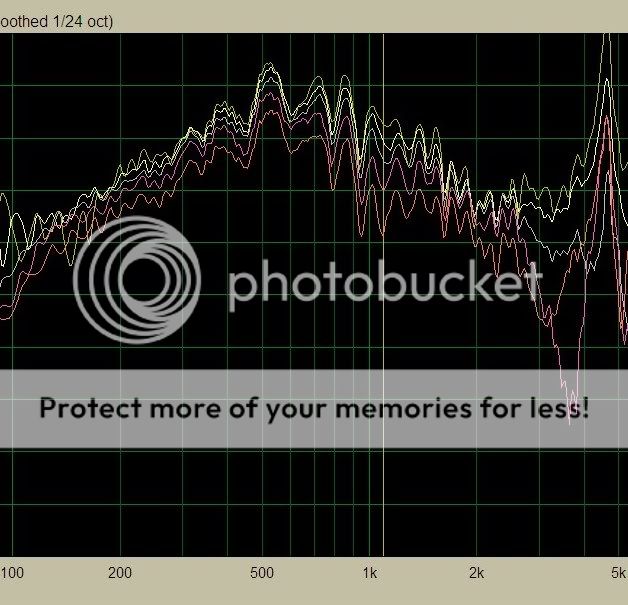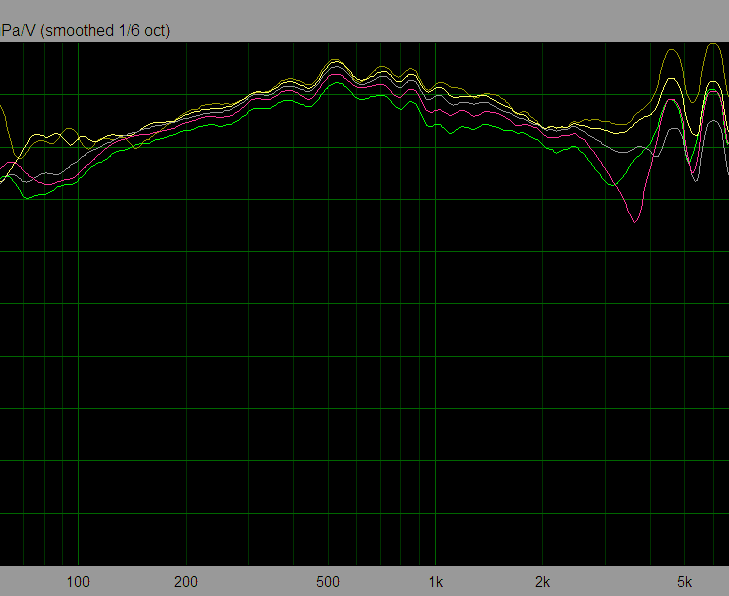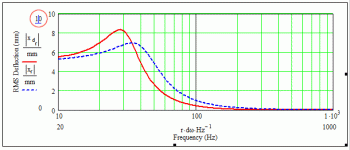Rudolf,
Got it ! Thanks !
When I talked of 7 mm (in absolute terms) cone movement in post #327 I applied the rule of thumb multiplication with SQR(2) to get a reasonable measure including most all of natural spread. I would think this is a reasonable way of dealing with measures like this.
/Erling
Got it ! Thanks !
An externally hosted image should be here but it was not working when we last tested it.
When I talked of 7 mm (in absolute terms) cone movement in post #327 I applied the rule of thumb multiplication with SQR(2) to get a reasonable measure including most all of natural spread. I would think this is a reasonable way of dealing with measures like this.
/Erling
Last edited:
😀Got it ! Thanks !
Hi Erling,
Sorry, I should have been a bit more detailed in my description.🙄
Like this:
Attachments
Michael, could you rotate your 'thong baffle' 45deg in the baffle plane and do a set of polars? So the frame looks like a diamond (corners point up/down)?
You are thinking along the same lines!
🙂
Will take some time to do a little bit of playing around to possibly find a solution to the 4kHz polar peak.
But anyway, I already consider the current "thong baffle" to be exceptionally good - haven't seen such smoothly extended polars measured elsewhere for a speaker that size ! - have you ?
Michael
Great stuff guys. These are my measurements of Seas L21 (W22's poorer cousin) on narrow 24 cm baffle. Outdoor and ungated. They are very uniform up to 2k+, may go outside again and measure it with no baffles ...
With outdoor measurement the -6db/oct dipole droop clearly revealed.
no smoothing:

with smoothing:

With outdoor measurement the -6db/oct dipole droop clearly revealed.
no smoothing:

with smoothing:

Last edited:
Hi Michael:Below my polar measurements of a 8" and 6" in a 30cm / 12" wide baffle and without any baffle taken indoor with a gating of ~4ms (so forget anything below ~300Hz).
8" is the Jantzen JA8008
6" is the B&C 6PEV13
To make even more clear what Sitg Erik and Cuibono have outlined I normalised FR to on axis response.
What we see is a virtually perfect equalised an axis response and the corespondent polars at 10, 20, 30, 40, 50, 60 deg

Above the 8" Jantzen JA8000 in a 30cm / 12" wide OB

Above the 8" Jantzen JA8000 in a 30cm / 12" without any baffle

Above the 6" B&C 6PEV13 in a 30cm / 12" wide OB

Above the 6" B&C 6PEV13 in a 30cm / 12" without any baffle
Uups – the top end polar's are way better without a baffle (as already been said)
Comparing the two different speaker size' - both without any baffle - it comes as a surprise that the 8" is *smoother* (up to ~2500kHz) than the 6" !
seem to be perfectly reasonable to still cross the 8" at ~ 1500Hz
Comparing the two speaker in the same baffle the 8" speaker clearly wins by a large margin.
To be fair, we possibly would have to measure the 6" in a proportionally smaller baffle.
Also can be seen the dipole –6dB at 60deg isn't true for *both* speakers. I think this is due to the same reason as 90deg never measures 0dB – simply the asymmetry due to the motor structure.
One conclusion seems to be a safe bet, taking a smaller speaker does not necessarily turn out in smoother top end dipole polars - its individual for any speaker and subject to measurement
What can't be seen here is that the penalty is roughly a - 6dB SPL loss for the nude speaker variant
Michael
Would it be possible for you to do the same set of polar measurements from the rear of the driver?
Regards,
Charles
Hi Michael:
Would it be possible for you to do the same set of polar measurements from the rear of the driver?
Regards,
Charles
Sorry - I will not take the effort - it took me almost a full weekend to share above measurements.
There are some rear OB measurements around - also from SL or linked at Rudolfs page (scroll down)
Welche Lautsprecher für OB?
On the other hand - I might come along with some more interesting measurement regarding optimization of OB polar behaviour with big low-mid units - looks interesting for now but needs time consuming refinement and checking back.
Michael
On the other hand - I might come along with some more interesting measurement regarding optimization of OB polar behaviour with big low-mid units - looks interesting for now but needs time consuming refinement and checking back.
Sadly further improvement of polar pattern in OB turned out to be a dead end.
Front to rear asymmetry seems to be too big with usual speakers to let me establish any useful prediction form my trials.
Here – as an inspiration - where I actually was heading


#########
But at least - I can share measurements of an additional 8" speaker (well known Dynaudio 21W54) that makes clear that even comparable speakers show *widely* different polar behaviour in OB – not only - but especially in the sensible 1kHz region.

Above the ancient 8" Dynaudio 21W54 measured without any baffle (and intact surround !).

Above again the 8" Jantzen JA8000 without any baffle for direct comparison
Michael
Last edited:
Hi Michael, thanks for that!
What about the tweeter polar response you've been working on, the "dipole horn"?
I think tweeter frequency is stil the achiless heel of typical dipole setup.
What about the tweeter polar response you've been working on, the "dipole horn"?
I think tweeter frequency is stil the achiless heel of typical dipole setup.
Which compromise is more desirable:
1) fewer crossover circuits from using a single driver for the midrange like the Linkwitz Orion, and accepting degraded polar response; or
2) improved polar response from using several size optimized speakers, and accepting tone and phase effects of multiple crossover circults over spaced speakers?
Some 8" and 10" midbass drivers appear to have better polar reponse curves than the more common 6" midranges up to 1Khz. I favor the dynamics and coherence of a single 8" or 10" midrange and I always watch for the best speaker curves and baffle designs... like mige0's Dynaudio 21W54 better than expected polar measurements.
1) fewer crossover circuits from using a single driver for the midrange like the Linkwitz Orion, and accepting degraded polar response; or
2) improved polar response from using several size optimized speakers, and accepting tone and phase effects of multiple crossover circults over spaced speakers?
Some 8" and 10" midbass drivers appear to have better polar reponse curves than the more common 6" midranges up to 1Khz. I favor the dynamics and coherence of a single 8" or 10" midrange and I always watch for the best speaker curves and baffle designs... like mige0's Dynaudio 21W54 better than expected polar measurements.
My open baffle dipole with Beyma TPL-150 has turned into:
My open dipole without baffle and without Beyma TPL-150
Why? I had some Mundorf AMT2340's lying around, just had to test them.
With a small baffle: disaster
Without baffle: even worse
Without the frontplate: wonderful!
The bare driver measures very very nice both on- and off-axis. Surprisingly, its fairly flat to 1.5 kHz, with a resonance peak at 1.2 kHz. No problem crossing it somewhere around 1.7 kHz. 🙂
Also - in my search for more optimized off-axis response, I changed the woofer to a cute little 15". Very small woofer indeed. I had a couple of Beyma 15P80nd. They sound really nice in the midrange and upper bass. Of course there is not much low bass, so I cross over to my closed box 18" subs around 50 Hz. (yuck - that omnipole bass s*cks...). There will be H-baffles with the 21" Beyma replacing the boxes soon. I cant stand the muddy crap that comes out of those closed box monsters!
Oh well, this is what it looks like now. The Beyma 15" was easy to hang by the way, there are M5 threads in the plate holding the magnet to the frame that can be used here, as the picture show.
My open dipole without baffle and without Beyma TPL-150
Why? I had some Mundorf AMT2340's lying around, just had to test them.
With a small baffle: disaster
Without baffle: even worse
Without the frontplate: wonderful!
The bare driver measures very very nice both on- and off-axis. Surprisingly, its fairly flat to 1.5 kHz, with a resonance peak at 1.2 kHz. No problem crossing it somewhere around 1.7 kHz. 🙂
Also - in my search for more optimized off-axis response, I changed the woofer to a cute little 15". Very small woofer indeed. I had a couple of Beyma 15P80nd. They sound really nice in the midrange and upper bass. Of course there is not much low bass, so I cross over to my closed box 18" subs around 50 Hz. (yuck - that omnipole bass s*cks...). There will be H-baffles with the 21" Beyma replacing the boxes soon. I cant stand the muddy crap that comes out of those closed box monsters!
Oh well, this is what it looks like now. The Beyma 15" was easy to hang by the way, there are M5 threads in the plate holding the magnet to the frame that can be used here, as the picture show.
An externally hosted image should be here but it was not working when we last tested it.
An externally hosted image should be here but it was not working when we last tested it.
I'd like to add that the tiny 15" weighs just 3.6 kg, compared to the 14.9 kg 21". Going smaller and lighter will make it easier to design a nice looking speaker I hope.
My open baffle dipole with Beyma TPL-150 has turned into:
My open dipole without baffle and without Beyma TPL-150
Why? I had some Mundorf AMT2340's lying around, just had to test them.
With a small baffle: disaster
Without baffle: even worse
Without the frontplate: wonderful!
Hi Erik, can you provide some more details of the comparison between the beyma and the mundorf amt?
Also, how easy was to remove the plate from the 2340?
Hi Erik, can you provide some more details of the comparison between the beyma and the mundorf amt?
Also, how easy was to remove the plate from the 2340?
First - there is some 6 dB difference in sensitivity. Being a lot bigger, the TPL does not have as good aff-axis behaviour as the Mundorf (hope to do some proper measurements to show here in a few days). That being said, they sound more or less the same....
Very easy to remove the Mundorf front plate. There are four small screws, just remove them and the plate comes off.
This is by far the best thread lately!
Have you tried the Bohlender Graebener Neo3PDR? It should give really nice response because of it's small size and shallow depth, at least my gut feeling tells me so!
I use it in my dipoles and apart from it's VERY decent price it sounds wonderful too!
Have you tried the Bohlender Graebener Neo3PDR? It should give really nice response because of it's small size and shallow depth, at least my gut feeling tells me so!

I use it in my dipoles and apart from it's VERY decent price it sounds wonderful too!
Yeah, I like the Neo3. Very good value. I do think I have some lying around.... maybe I have to test them out in dipole as well! 🙂 I've used them before in various speakers, they always sounded really nice.
Bohlender Graebener NEO 3

as dipole nude (without baffle) at 0 10 20 30 40 50 60 deg :

#######
Same for 0 10 20 30 deg smoothed at 1/3 octave:

🙂
Michael

as dipole nude (without baffle) at 0 10 20 30 40 50 60 deg :

#######
Same for 0 10 20 30 deg smoothed at 1/3 octave:

🙂
Michael
Last edited:
Neo3 bottom end
That's a lot more bottom end below 2k than I usually see posted in the measurements of a Neo3.Bohlender Graebener NEO 3 nude (without baffle) as dipole at 0 10 20 30 40 50 60 deg


🙂
Michael
Bohlender Graebener NEO 3 PDRW
http://www.parts-express.com/pe/showdetl.cfm?Partnumber=264-735




🙂
Michael
http://www.parts-express.com/pe/showdetl.cfm?Partnumber=264-735




🙂
Michael
Last edited:
- Home
- Loudspeakers
- Multi-Way
- My open baffle dipole with Beyma TPL-150
